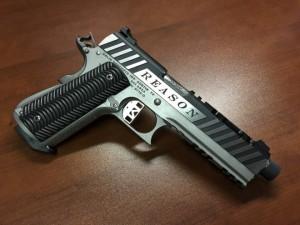 The history of newspaper publishing is rich with improbable doomsday scenarios that are hyped up beyond seriousness, especially when someone invents some new technology that is difficult to understand. Facts or reality only seemed to matter in the thinnest sense of the words, and an actual grasp of the technology being demonized was never really required. For the most part, large nationally distributed newspapers have done a pretty good job of leaving those days of sensationalism behind them. So I was pretty surprised when I saw this recent blog post from the Monkey Cage section on the Washington Post. Honestly, had I not known what website I was on, and double checked the URL, I would have assumed that I was reading a story written by a crackpot conspiracy theorist. It is probably one of the most absurdly inaccurate and misleading stories about 3D printing technology that I’ve ever seen. The title of the post? “You can print your own guns at home. Next it will be nuclear weapons. Really.”
The history of newspaper publishing is rich with improbable doomsday scenarios that are hyped up beyond seriousness, especially when someone invents some new technology that is difficult to understand. Facts or reality only seemed to matter in the thinnest sense of the words, and an actual grasp of the technology being demonized was never really required. For the most part, large nationally distributed newspapers have done a pretty good job of leaving those days of sensationalism behind them. So I was pretty surprised when I saw this recent blog post from the Monkey Cage section on the Washington Post. Honestly, had I not known what website I was on, and double checked the URL, I would have assumed that I was reading a story written by a crackpot conspiracy theorist. It is probably one of the most absurdly inaccurate and misleading stories about 3D printing technology that I’ve ever seen. The title of the post? “You can print your own guns at home. Next it will be nuclear weapons. Really.”
Yes, really, that is the actual title of an article that was written for the blog of a nationally distributed and well respected newspaper. In the article written by Daniel C. Tirone and James Gilley (Yes, it took two people to write it) the pair piggyback their handwringing over 3D printable weapons onto the current rash of mass shootings in the United States. While the subject of gun violence in the country is a serious and important topic that we need to address, I’m going to be a little cynical and suggest that maybe using the tragedies of mass murders to try and legitimize what comes uncomfortably close to straight up fear mongering is kind of gross. That’s just me and my having a pesky soul. The article proceeds to completely misrepresent what actual 3D printed guns can do before suggesting that 3D printing will soon be able to create biological weapons and even produce actual nuclear weapons. Here are a few excerpts of the frankly staggering amount of wrong that this article contains.
“The ability to ‘print’ or manufacture guns privately will allow individuals to bypass background checks, the primary way that guns are regulated today. And that challenge will expand exponentially as the technology advances, one day enabling individuals to print chemical, biological and nuclear weapons of mass destruction at home.”
“How do you run background checks on someone who can print a gun at home?”
Well, you don’t I guess. But you also don’t run background checks on people who make their own firearms using traditional gun manufacturing methods with plans that are easily accessible to anyone online either. Yes, that’s right, anyone can download plans to make their own guns from the internet and have been doing so since the internet existed. You can even check out books at your local library that walk you through the process.
But okay, sure, let’s pretend that it isn’t almost the same thing just for argument’s sake.
“This is not a futuristic speculation; 3-D printed handguns are already on the street. The government is struggling to respond to these guns, which are hard to detect and deadly.”
Except for the part where any “3-D printed handguns” currently on the street are about as deadly as a BB gun, sure. The 3D printed handgun that they are worried about is the Liberator handgun from Defense Distributed by the way. While it is certainly impressive that a working firearm was made using 3D printed parts, it is hardly a weapon that needs to be feared. It is made of fragile plastic, capable of firing only a single shot, and isn’t especially small or easy to hide. I still have to take off my shoes when I board an airplane after a single failed shoe bomb, if law enforcement was really afraid of 3D printed guns then they wouldn’t be ‘struggling’ to put measures in place to screen for them.
Now I don’t want to diminish the actual issue of 3D printed handguns here in the least. Truthfully, the government is going to need to find a way to regulate 3D printed weapons at some point. And I see no problem with people looking forward and trying to bring the issue up for discussion. Had Tirone and Gilley stopped here I probably wouldn’t have even noticed the story, but they’ve only just begun working themselves up into histrionics.
“First, terrorists are now more willing to utilize WMD than before. Bruce Hoffman has argued that while at one point the conventional wisdom was that terrorist groups had no desire to inflict mass casualties, the 9/11 attacks and the rise in religiously motivated terrorism showed that this logic no longer holds.”
“Second, the opportunity to use WMD will expand as 3-D printing makes these weapons more available. In the past, only countries could reliably manufacture WMDs, given the formidable technical and economic investments involved.”
Both of these statements are vaguely true I guess, but exactly what type of “WMDs” will be 3D printable? What technologies will be employed to create them? If you know anything about the 3D printing industry, then you’re probably pretty aware of what the major 3D printing applications and technologies are. There isn’t a 3D printer in existence that can just pop out guns or chemical weapons, at least not without an enormous investment of money and time.
“When will 3-D printing become advanced enough to produce WMDs? Though it sounds like science fiction, the best projections suggest that it will happen within a few decades. The technology to print from standard metals such as steel and titanium already exists, allowing for firearms far stronger than the roughly made and fragile plastic handgun.”
Sure, metal parts can currently be 3D printed… using special 3D printers that cost tens if not hundreds of thousands of dollars. And yes, there have been some metal guns manufactured by large 3D printing services bureaus, but they cost about $12,000 to produce. For a single gun. I know it is easy to assume that criminals are stupid, but that level of fiscal irresponsibility is quite a stretch.
And even had the article stopped here it probably wouldn’t have ended up on my radar, but Tirone and Gilley continue:
“Progress in mixed-materials printing, which can currently use 14 materials in the same printer, is being made both in the laboratory and among hobbyists. Work in biological materials is expanding at a rapid pace, with scientists printing human organs, medications and even hamburgers; bacteria and chemicals aren’t far behind. Production is also moving beyond simple items, allowing for the fabrication of increasingly complex objects.”
“As an example, SpaceX is utilizing innovative 3-D printing techniques to manufacture components for its spacecraft and rocket engines. It should also be possible to use 3-D printers to print components needed to produce nuclear weapons, potentially even from fissile materials such as uranium or plutonium.”
Yes, metal 3D printers can now somehow 3D print uranium and plutonium. I suppose someone could, possibly, invest millions of dollars into developing technology capable of 3D printing with radioactive materials. But how exactly does that suddenly make radioactive materials available on the free market where terrorists can purchase them? I mean, if any terror group had some uranium or plutonium just laying around they could already make a dirty bomb for a few hundred dollars, why are they going to bother to invest millions of dollars into a machine that will make it look pretty?
The answer? They won’t. It is completely absurd to suggest that terror groups will be using expensive and highly advanced technology to do things that they can already do for a lot cheaper. ISIS is not going to buy themselves a metal 3D printer in order to craft themselves roadside IUDs. Criminals who want guns are not going to spend $12,000 on a 3D printed metal gun when they can just go buy the real thing for a few hundred dollars. And they’re most certainly not going to buy 3D printers to make one-shot plastic guns when they have access to metal guns for a fraction of the cost. That just isn’t how reality works.
There is a very real need to have some conversations about 3D printed weapons and emergent technology like additive manufacturing. But these are not conversations that should be had by journalists who don’t seem to be even trying to understand the technology that they’re writing about. Journalists don’t need to be scientists to write about technology, god knows that I’d be a hypocrite if they did, but they should at least make an attempt to understand exactly what it is that they’re writing about.
I know newspapers, even their blogs, usually have tight deadlines. But it doesn’t take a lot of research to discover that a 3D printer capable of using materials strong enough for a dangerous gun are far too expensive to be practical. It doesn’t take a lot of research to discover that metal 3D printers are material-specific and they can’t just 3D print anything from any metallic material. And oh man it doesn’t take a lot of research to discover that they most certainly cannot magically create uranium or plutonium for goodness sake. I know some tech sites like to call the 3D printer a precursor to Star Trek’s replicators, but we’re a few centuries away from that, I promise.
Discuss this story in the 3D Printed Nukes forum thread on 3DPB.com.
Subscribe to Our Email Newsletter
Stay up-to-date on all the latest news from the 3D printing industry and receive information and offers from third party vendors.
You May Also Like
3D Printing News Briefs, April 13, 2024: Robotics, Orthotics, & Hypersonics
In 3D Printing News Briefs today, we’re focusing first on robotics, as Carnegie Mellon University’s new Robotics Innovation Center will house several community outreach programs, and Ugogo3D is now working...
Rail Giant Alstom Saves $15M with 3D Printing Automation Software 3D Spark
3D Spark has entered into a three-year deal with the rail giant Alstom. Alstom, a transport behemoth with annual revenues of $16 billion, specializes in the manufacture of trains, trams,...
Meltio Expands Global Reach with New Partnerships in the Americas and Europe
Spanish 3D printing manufacturer Meltio has expanded its sales network across the globe. With the addition of three new partners in the United States, Brazil, Argentina, and Italy, Meltio aims...
3D Printing Webinar and Event Roundup: April 7, 2024
Webinars and events in the 3D printing industry are picking back up this week! Sea-Air-Space is coming to Maryland, and SAE International is sponsoring a 3D Systems webinar about 3D...

































